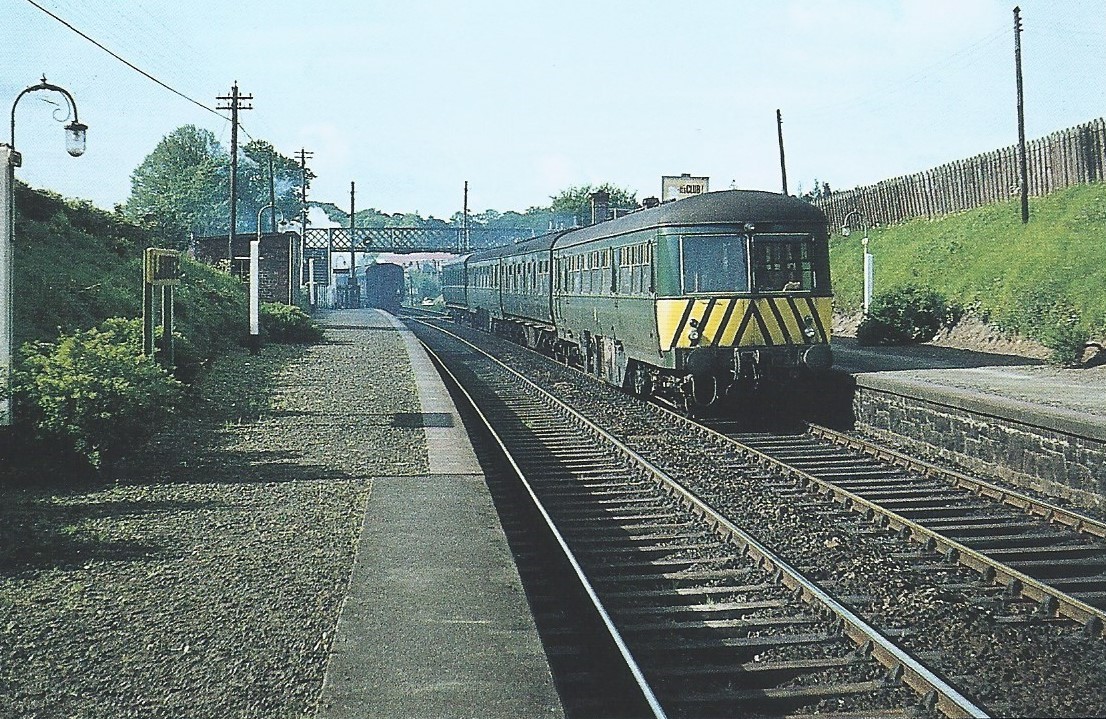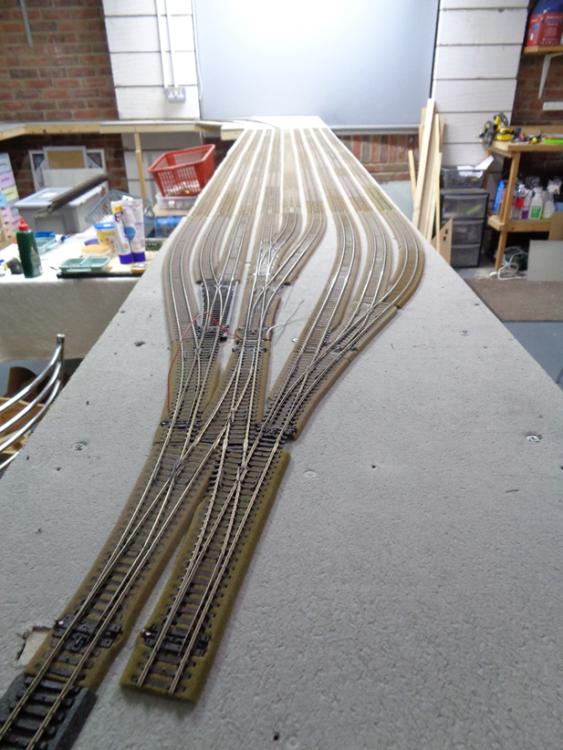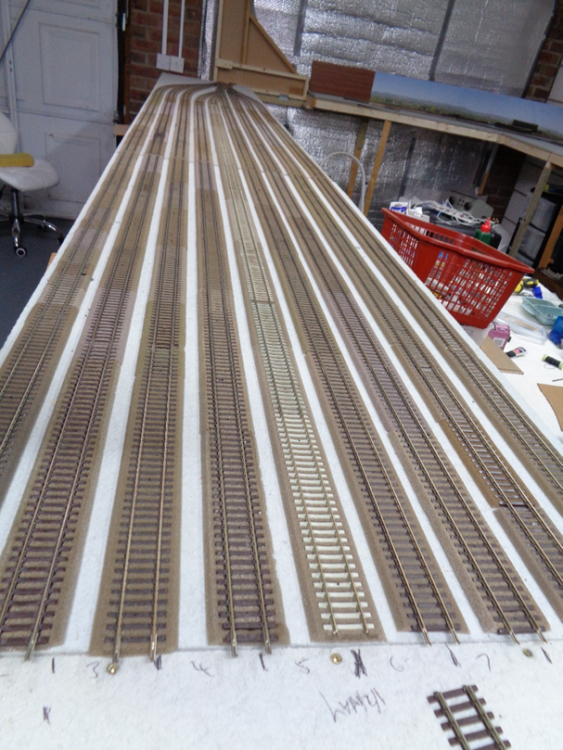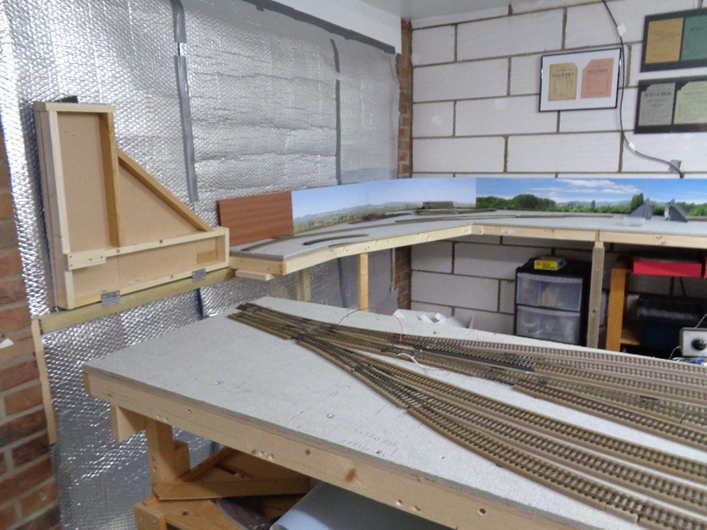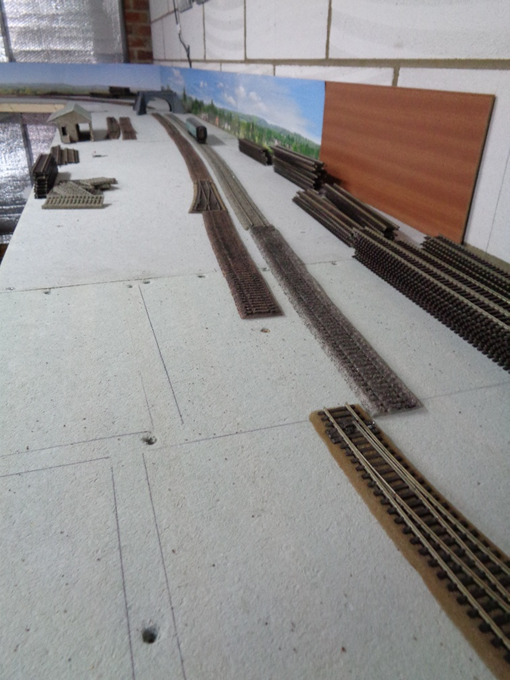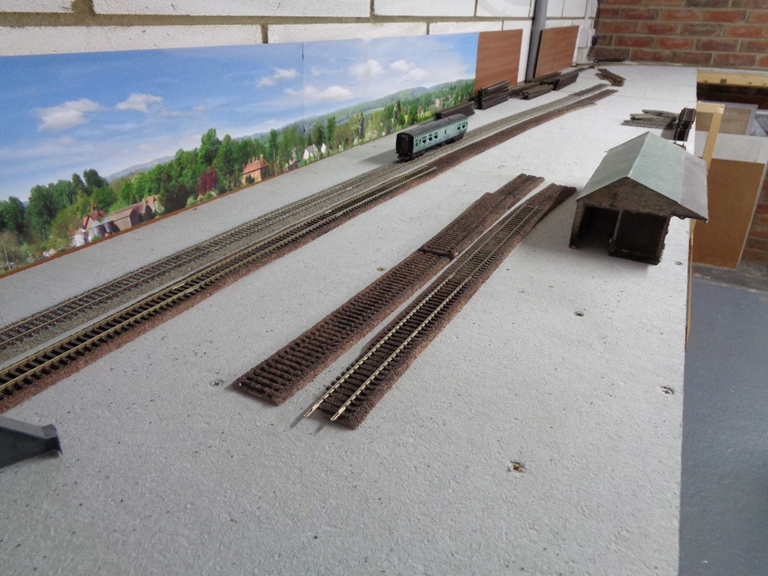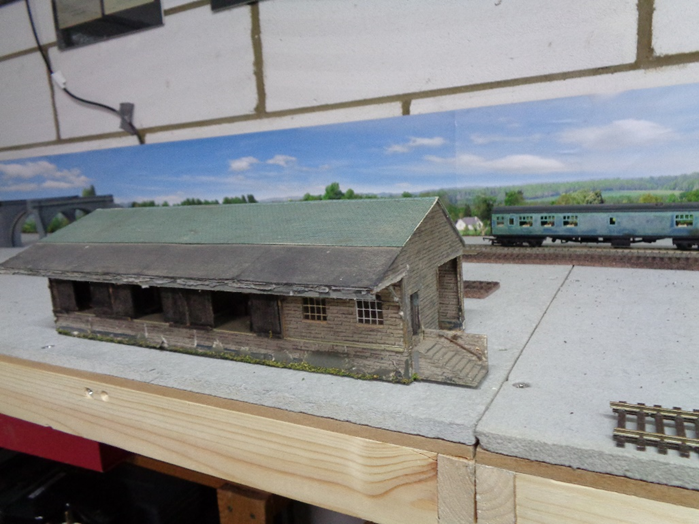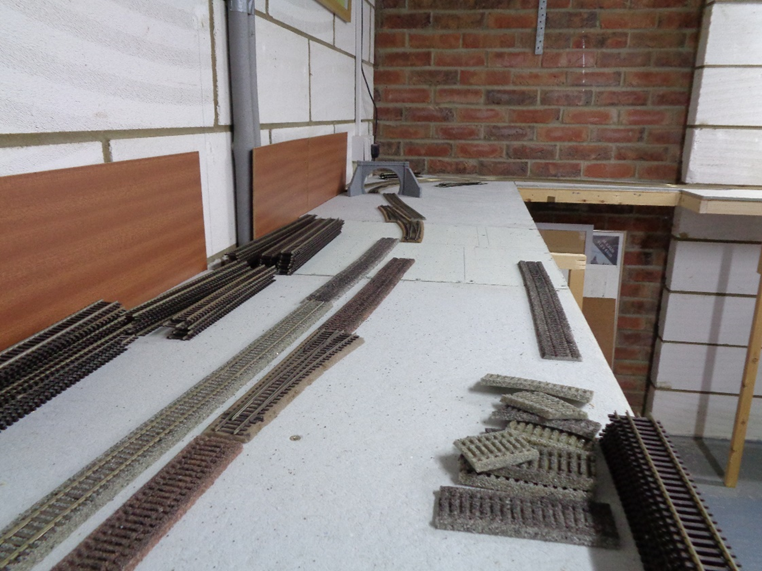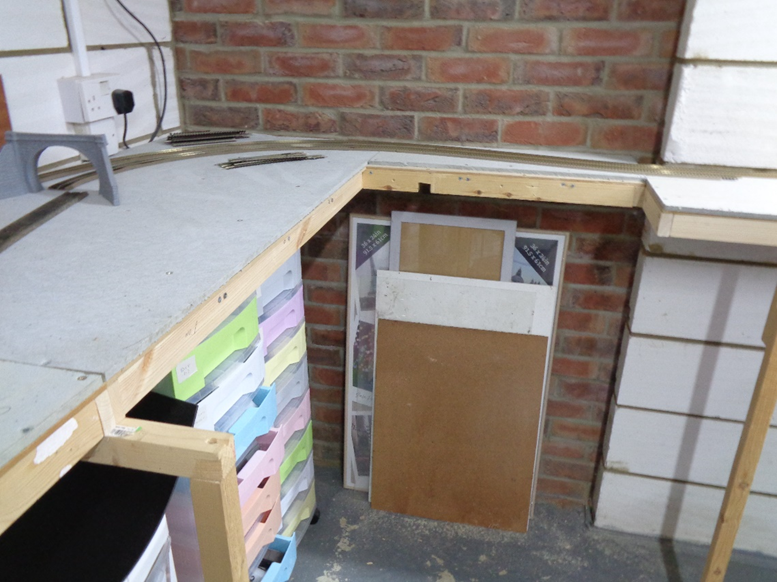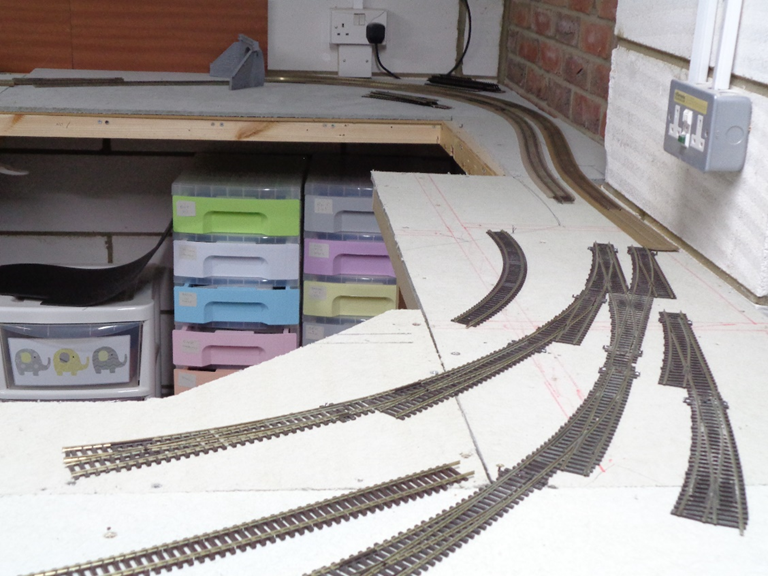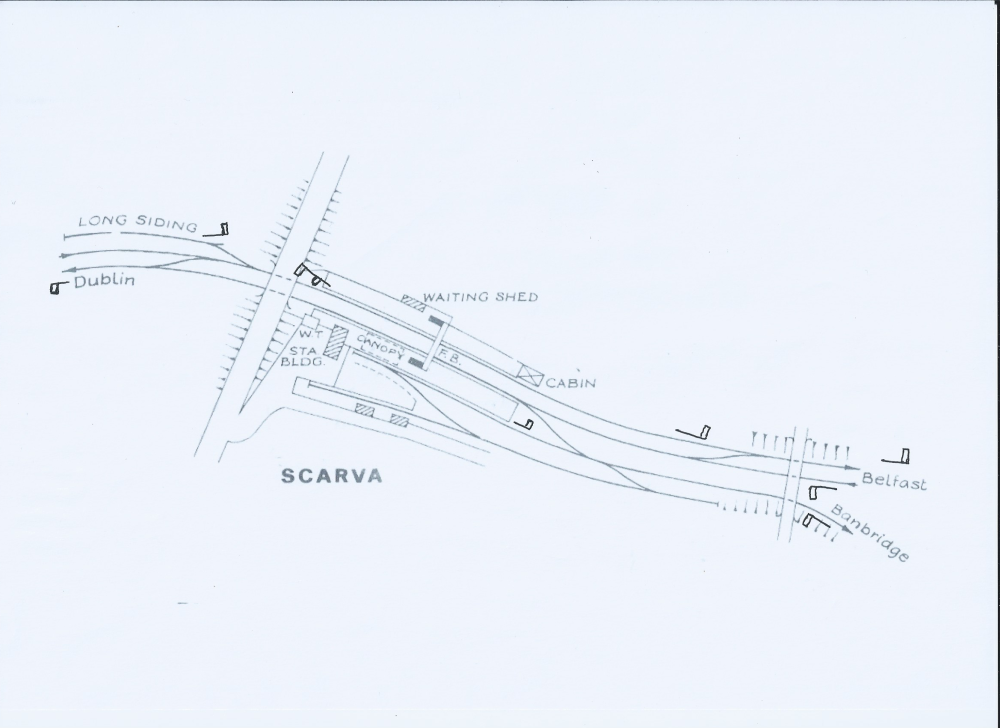-
Posts
433 -
Joined
-
Last visited
-
Days Won
3
Content Type
Profiles
Forums
Events
Gallery
Blogs
Store
Community Map
Everything posted by Lambeg man
-
Some photo's to show progress to date - The overall layout size is 18' x 10', with the station area against the side wall of the garage and the Hidden Sidings in the center. (Above)The Hidden Sidings are down. 9 roads in total, 3 through UP loops, 3 through DOWN loops and the center 3 roads are reversible. (Above) Hidden Sidings viewed from the opposite end to the previous photo. (Above) The corner lifting section (in the up position) chosen for here as it is the only section with only two tracks on it. Sliding rail joiners provide electrical connection AND ensure correct track alignment when the section is lowered in place. Simples! (Above) Overall view, looking south, of what will be the main station area. (Above) Overall view, looking north, of what will be the main station area. (Above) Closer look of the Goods Shed that MY version of Scarva will have. Bought it for £2 about 35 years ago second hand from a shop. Lots of bits have fallen off, doors, guttering, etc., but I have saved them and hope to restore it to it's former glory. It has lighting installed and it looks "Irish" to my eyes. (Above) View of the station throat area looking north. The right hand point in the foreground is for the Branch connection. The trailing crossover between the UP and DOWN lines is seen in the distance. (Above) Once the main running lines are pinned down in the far corner, the immediate central area of this photo will be fitted with a trimmed 3' x 2' sheet of ply fitted underneath the existing support batons. The Branch Line will then leave the board are on the left of the picture and run over an embankment to reach the board edge seen on the right of the picture. The embankment will cross over a derelict section of canal by a small bridge. I feel that even a small amount of 'embankment' will bring some relief from everything else tending to be in cuttings. (Above) View of the yet to be sorted other end of the Hidden Sidings. The solitary 21" Setrack curve seen in the center of the picture shows roughly where the Branch Line will come around after crossing the embankment, then hitting level ground before going under a road bridge. Before anyone starts about my deviations from the original, remember - RULE ONE!
- 13 replies
-
- 11
-

-

-

-
Many thanks to BSGSV for providing a full answer to this one. The down line was provided with a distant, then an outer home, then an inner home that was sited outside the 'Long Siding' for sighting purposes. The up starter was around the bend from the platform and there was an advanced starter further on. The same arrangement applied for the up line, the double armed repeater up starter being on the down platform. At the north end of the up platform was a starter for the branch bay only. A single branch home was situated beyond the bridge. The two trailing crossovers between the up and down main lines, the lead into the branch and the access to the 'Long Siding' were all provided with shunting disc ground signals. BSGSV states "I don't see any discs acting as running signals, just for shunt moves. I'm surprised that the branch was as self-contained as it was. There's no running signals to get passenger trains to the branch from the main line, or vice versa. Compared to the main line part of the layout, shunt discs on the branch and its run-round are quite sparse. It's just a layout for a branch train shuttling to and from the bay platform.
-
My first ever internet postings were on the RM Web site and they were about my “Lisburn North” layout. Although I received positive appraisal from viewers, the first version suffered from the fact it had to be operated and viewed from the front like an exhibition type layout. Access to the ‘hidden sidings’ required constant ducking under the front boards and this proved problematic. A house move in February 2021 allowed a rebuild in a slightly bigger garage with operation and viewing from the centre, with a lifting section being incorporated to allow easy access to the centre. However by sticking with the “Lisburn North” concept, this resulted in only 35% of the whole oval being available for the scenic section. I have therefore recently dismantled the last “Lisburn North” layout completely and made a fresh start (with rebuilt baseboards) on a new project. I gave up years ago on ‘terminus to fiddle sidings’ type layouts, as I prefer a ‘watching the trains go by’ type layout. Therefore it has to be something on the ex-GNR main line. In my copy of Golden Years of the Great Northern: Part Two purchased 42 or so years ago, I had pencilled in over the track plan of Scarva station how it could be done in 16’ 00”. As I now I have 18’ 00” to play with I have revisited this idea. However under Rule One, this ‘Scarva’ is different to the original as in real time the Banbridge branch was closed in 1955 by the GNR(B). However in my scenario, although passenger services have been withdrawn, the branch is retained for goods traffic to TWO linen mills, as was the case (albeit only one) with the extended stub of the Derry Central line. Scarva station may also get a full sized Goods Shed if only because I have one! This will allow for a ‘branch terminus’ alongside the Hidden Sidings with a station layout not dissimilar to Milford on the Armagh-Keady branch line, a long platform for the very occasional passenger special, with a loop to allow the shunting of mill wagons to an unseen destination. The building of this new layout is underway with track laying in progress. While I had the track plan from the Arnold book as a guide, I recently posted an appeal for information about the original signalling at Scarva. I am very grateful to BSGSV of this parish for helping out with that one. As it may be of interest to others as to the apparent paucity of signals in published photo’s, I attach an amended copy of the track plan from the Arnold book (with acknowledgement to Blackstaff Press) showing the signals, many of which were well away from the usual photographer’s position on the road bridge. The Advanced Starters were much further out than I have indicated.
- 13 replies
-
- 10
-

-

-
For the American version of the 'Dambusrers' movie, they muted the 'N' word. In the scene with the dog outside the briefing room, the guard on the door is a very young Patrick McGoohan in his first ever (non-speaking and unaccredited) movie appearance...
-
My ex-father-in-law was a rear gunner on a Lancaster during the war. He was in the 'Pathfinder Squadron' based at RAF Scampton. He had some interesting stories about his service. One night they had dropped their incendiaries (markers) over the target and on the way back a German night fighter caught up with them. Old George let rip with his four Brownings and matey pulled back before coming in for another go. This toing and froing continued for about 20 minutes, until the Lanc reached the coast. As George let go his last rounds, the German dipped his wings as if in salute! I also remember him telling me how in the dying hours of the war, Bomber Command suddenly switched from dropping bombs on Germany to dropping food supplies over Holland. He was understandably bitter like many other Bomber Command crew that they received no official recognition after the war, such as a campaign medal. Also related info is that up until circa 1978 when a form of radar was installed to aid the gunner's aim, the Chieftain tank had a .50 Browning machine gun (the same that used in the Lancaster) fitted in the turret as a 'ranging device' for the main gun. I would get out more, but I have too many eggs to count...
-
Of course those eggs are going into a Belfast war time product, a 'Short Stirling'... Often wondered why Avro chose the city name of 'Lancaster' for their four engined bomber, yet Shorts named their's after a city in Scotland? Of course there was another production named the 'Halifax'. Was that named after the Yorkshire city or as a gesture to a then prominent politician? British Army main battle tanks for many years were always given names that began with the letter 'C'. Cromwell, Churchill, Centurion, Chieftain, Challenger, etc. Army logic. Where the 'Brycleem Boys' choose their kite names defys any logic... Over to you Galtemore...
-
On second thoughts, bugger the eggs - stay with the RAF stories!
-
Can we please get back to EGGS!
-
Right, let me throw my tuppence worth in on this... When I was a wee lad we had 'Hallowen' in Ireland on the 31st October. We let off fireworks (until 1970 in the North when the security situation forced ban), we dunked for apples and had sweets provided by our parents. We had apple pie with thrupenny and sixpence coins hidden in it. We did NOT go 'Trick or Treating'. Meanwhile on the GB mainland they celebrated 'Guy Fawkes Night'on the 5th November, let off fireworks and did "Penny for the Guy" money collections. They did NOT do 'Trick or Treating'. In circa 1978 along comes a fecking US movie 'Hallowen' and suddenly the 5th of November slides into the memory in GB and now the youth factor are all doing 'Hallowen'. F**k "Penny for the Guy". Let's now go 'Trick or Treating'. This is tantamount to demanding money (or good quality sweets) with menaces from some of the most vulnerable people in the district. EGGS are essential ammunition for this purpose. Having your front windows splattered with eggs may well be very upsetting for an elderly person, but it does not constitute 'Criminal Damage' in English law. In the late 1980's the problem was escalating year on year. As a police officer, on 31st October, my colleagues and I would foot patrol and challenge all youths we met. "Have you got any eggs?" Reply - "No." "Good, because I 'm not going to formally search you, I will simply clap my hands on your jacket pockets. There, job done, Good night." I made no breach of the police codes in my action, but the individual soon left for home to clear the mess out of his jacket pockets! In later years I secured a voluntary agreement from the local Retailers Association that they would not sell eggs on 30th/31st October to anyone under 16. Job done. LM
-
When did you join? You must have been only 7 years of age.
- 35 replies
-
- 1
-

-
Many thanks to you both, your input has been very helpful. LM
-
Hi Larne Cabin, You and me appear to be in the same boat. I am attempting a rebuild layout based on Scarva, but finding time to do anything other looking after my wife (stroke victim) all day is difficult. Like you it means I manage only a few 10 minute segments in the garage. My thoughts are with you and you are not alone. LM
-
In respect of re-gauging, may I throw a spanner in the works as to the accuracy of the model. The move from 4' 8 1/2" to 5' 3" on the two locomotives in question was achieved by removing the driving wheels from their axles, REVERSING the driving wheels on each axle so that the flat front faced outwards and the "dish" profile faced inward. See several decent published photo's. Ergo, the model seen above is yet another repaint of a GB locomotive and not an accurate IRISH prototype! Off to bed now...
-
.thumb.jpg.619b7e43fcb01ddf7c110aacc1ea31d3.jpg)
Ernies Massive Irish 1930's to 2005 Photo Archive
Lambeg man replied to Glenderg's topic in Photos & Videos of the Prototype
Hi Ernie, This was where J. Edgington took the large group picture of the whole tour party. See the RPSI website for more. The first carriage is a 'C 2' All-First in "1953 Royal Train" livery, blue/cream sides, black ends. -
.thumb.jpg.619b7e43fcb01ddf7c110aacc1ea31d3.jpg)
Ernies Massive Irish 1930's to 2005 Photo Archive
Lambeg man replied to Glenderg's topic in Photos & Videos of the Prototype
Hi Ernie, Is there a possibility this was taken in December 1960? The reason I ask is that if it was 1955, the AEC Railcar on the left of the picture would be in GNR Blue/Cream livery. This one appears to be in all over CIE green, it therefore being the final Railtour? Goods services continued for another few weeks after the date of the Railtour. -
.thumb.jpg.619b7e43fcb01ddf7c110aacc1ea31d3.jpg)
Ernies Massive Irish 1930's to 2005 Photo Archive
Lambeg man replied to Glenderg's topic in Photos & Videos of the Prototype
Hi Ernie, Yes, I read somewhere that the Bundoran turntable was extended in 1934/35 to accommodate the then new Railcar 'C' which worked out from Enniskillen when first introduced. LM -
.thumb.jpg.619b7e43fcb01ddf7c110aacc1ea31d3.jpg)
Ernies Massive Irish 1930's to 2005 Photo Archive
Lambeg man replied to Glenderg's topic in Photos & Videos of the Prototype
I drove around that south Connemara area in 1989 and was amazed at how much of the infrastructure of the Clifden branch had survived. Bridges, station buildings, etc.. No industrial pressure over 60 years helps! -
I am in the mind to model an adaptation of the layout at Scarva. However a study of all available pre-1962 (when the cabin was abolished) photographs gives little indication of where the signals were. One Camwell photo from 1949 (when the footbridge in the middle of the station was still in place) shows the double UP starter on the DOWN side just before the road bridge so favoured by most photographers. Surely there must have been starters at the end of the northern end of the UP and Branch platform? Any advice gratefully received. .
-
I recall a story told to me around 1969 by someone "in the know", that the MPD sets stationed in Ballymena for the early morning Belfast runs were left idling overnight as a precaution against them not starting. I can state from experience in such matters, that starting a large diesel engine from cold requires a substantial amount of battery power.
-
.thumb.jpg.619b7e43fcb01ddf7c110aacc1ea31d3.jpg)
Ernies Massive Irish 1930's to 2005 Photo Archive
Lambeg man replied to Glenderg's topic in Photos & Videos of the Prototype
I think there is a mention in NCC Saga about the Derry (Waterside) turntable being moved to it's later position on the east side of the running line as the one seen in the photo was too small to accommodate a Mogul. -
.thumb.jpg.619b7e43fcb01ddf7c110aacc1ea31d3.jpg)
Northern Ireland Shed Allocations?
Lambeg man replied to RaglanRoad's question in Questions & Answers
I',m not sure engines were ever "allocated" to particular sheds in the manner of BR. For example, Irish locomotives never wore SHED PLATES in the manner of BR locomotives. Obviously GNR 'V' & 'VS' class locomotives were allocated to either Adelaide or Amiens Street following an overhaul and perhaps engines were for a time regarded as being Dublin or Belfast based. GNR 'S' class were allocated on a seemingly ad hoc basis to Dublin, Dundalk, Portadown or Belfast. In respect of Adelaide, If one moves into the UTA era, ex-GNR 'VS', 'V', 'S' & S2', ''Q' & 'QL', 'P' & 'PP' 4-40's were "allocated" or "worked out of" Adelaide shed, as did the surviving 'T1' & 'T2' tanks. Likewise the four 'RT' tanks were always Adelaide engines. Any class of 0-6-0 (large and small) could be seen in the Belfast area and therefore notionally allocated to Adelaide. Post 1958 NCC ''W' & 'WT' became common. At one point in 1964 with the run down of steam operations, Portadown overtook Adelaide as the principle steam base on the ex-GNR system. The last operational engines working out of Adelaide were 'WT' Jeeps. Perhaps someone with greater knowledge than me can expand on this subject. -
The episode about the visiting Ukrainians was a sheer classic. "He's a Prod from East Belfast. He got on the wrong bus at Aldergrove and now he's stuck here in Derry surrounded by Fenians and Russians"
-
As is Ian McElhinney as "Joe". Issues around trains has to be accepted in the way that most of the "parents" are in real life only ten years older than most of the "Children". LM
-
Had they gone to the real Derry station, the joke about being on the wrong platform would not have worked. Such is the way TV works. While they all boarded a CAF (delivered about 7 years after the supposed date of the comedy setting) at Whitehead, the remainder was clearly shot in a preserved 450 set. So some credit there. Equally the gag line about the nun and the schoolgirl overhearing the booking office clerk's telephone conversation would not have worked in a modern booking hall. I love this programme and am amazed that my very English daughter-in-law absolutely loves it too. I will never look at a Kit Kat in the same light again! That said, current series episodes 2 & 3 have not matched the sheer quality of episode 1. Liam Nesson was awesome. LM
-
It has also been pointed out on another thread that another scam is an exaggerated price set on E-bay for an Irish railway item causing someone to contact the seller asking for a lower price, hence infecting their e-mail account. LM As for the above, bought a bottle of "Guinness Export" in Sainsburys last week. Got home and finally got my glasses on. "Brewed in Nigeria"!
.png.c363cdf5c3fb7955cd92a55eb6dbbae0.png)
